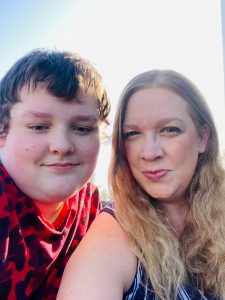Your Cart
The Truth About Caregiving
 Written by Amanda Morris
Written by Amanda Morris
Amanda Morris is the mother of a 14-year-old son who was diagnosed with an Acquired Brain Injury due to Meningitis at one week of age.
So… A doctor, and often multiple medical professionals have told you your child has a brain injury. What are your next steps? You contact your child’s school; you inform family members and friends. What is your reaction when they tell you that your child doesn’t look like they have a brain injury? Worse yet, what if your child’s school tells you your child doesn’t qualify for certain services because their brain injury doesn’t fit under their categorization for special education? What if the school offers some services under certain categorizations that doesn’t meet the continuity of care for your child’s brain injury?
What’s next?
The hardest part of our journey has been educating others on our son’s academic, social, and emotional needs. Brain injury doesn’t always affect one part of the brain, in my son’s case his injury is defined as diffuse which means different parts of the brain have been affected. Symptoms range from speech to social and emotional, and even ability to regulate pain, temperature, and hunger. The school’s job is to assess your child’s academic needs based on certain criteria, unfortunately this often means that your child’s needs aren’t fully addressed or even understood.
What can you do?
Become educated, educate others and advocate.
As a parent of a child with a brain injury, the responsibility to advocate for your child’s needs (sometimes complex) becomes your priority. The biggest mistake that I feel which has impacted our relationship with educators is becoming frustrated by being told what services and supports the school is willing (or not willing) to provide. What I realize is that our frustration is because people don’t understand brain injury and how it impacts a child in so many ways. Unfortunately, in our son’s cases, the multiple medical appointments, OT appointments, speech therapy appointments, orthopedic appointments, medical procedures, ICU visits and a multitude of seizure medications were often missed factors when different professionals evaluate my son for differing reasons, including providing him a free and appropriate education. This is where advocacy becomes an important resource in helping our son receive appropriate supports and services to succeed. The pain we watch our son endure creates frustration when those who have a responsibility to prepare our child for the future fail to understand the basic needs of our son’s brain injury. Turn your frustration into motivation! (Come out of your shell!)
I turned my frustration into motivation to help other children living with brain injuries, including my son. I recently took online classes and received my bachelor’s degree in the human services field. After running into the obstacle of acquired brain injury not being recognized as a traumatic brain injury in our local schools, I decided to initiate action to help remove a barrier that was standing in the way of children receiving appropriate services, supports and most importantly understanding in the school system. Working with Delegate Tony Wilt, Brain Injury Connections of the Shenandoah Valley, and the Brain Injury Association of Virginia, I was able to use my advocacy skills to help update and amend Virginia’s educational definition of Traumatic Brain Injury to include other causes of brain injury, including acquired brain injury. You can read and/or listen more about it here!
Using frustration as motivation to educate others is a healthy way to bring understanding to brain injury among the pediatric population. Our children’s brains are still growing, educating those who interact with our children is the best way to help our children build resilience to their brain injury and develop skills needed for lifelong functioning.
Where are we now?
Due to the pandemic, we have decided to homeschool. We have chosen to focus our time on helping our son develop life skills. This leaves more time for occupational therapy, appointments, and skill development. While every family’s situation is different, the best advice I can give coming from a parent perspective is that whatever you choose to do is ok. Often, there is not right or wrong answer in how we choose to provide our child with the best quality of life we can. I have spent countless hours wondering if decisions we have made have been the “right ones”, hours that would have been better spent helping our son achieve a positive quality of life. The best advice I can give is to relax, live life one day at a time and know that the right decisions are the ones we make that come from a place of creating positive changes for our child’s futures.
We live with our children and know what is best for them, trust your gut and intuition above the advice of those who may not have the education or awareness to give solid, unbiased advice. You’ve got this, and your child will thank you for it. Most importantly, remember to take care of you!
A special thank you to Amanda for sharing her story. If you are interested in sharing your story in a blog post, please submit a blog post!
